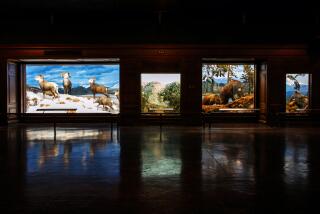To Entertain <i> and </i> Educate? A Monsterous Idea!
- Share via
When Chris Mays, a former TWA pilot, decided that he wanted to start a dinosaur manufacturing plant in Orange County, no one expected that someday 30 million people around the world would see his Gargantuan creations.
But today, seven years after Dinamation International began operating, the worldwide interest in Mays’ 90-foot Tyrannosaurus Rex, his Triceratops and other fierce, prehistoric creatures is thriving.
Company spokesman Mike Converse said Dinamation, which until now produced half-size replicas, just recently began producing life-size models of the now extinct creatures. Each dinosaur, usually made from Fiberglass or a specially made rubber, can stand as high as 90 feet and can cost more hundreds of thousands of dollars. Each model usually takes about 6 to 8 months to design, mold and paint.
Six of the first full-size replicas the company produces this year will be transported to Kasaoka, Japan, and placed in a entertainment park. Dinamation today has three manufacturing plants in Orange County and 60 full-time employees. The molding is done at the Santa Ana plant and the production and assembly of the figures takes place at two plants in Tustin.
Mays said he founded Dinamation not only to entertain the American public with his figures, which often are robotic, but to educate them.
“I see this company as fulfilling some pent-up frustrations I have about who have become the heroes of today. Primarily, they are created by the media, and they’re rock stars and drugged-out athletes. Why are these people our heroes? “ Mays said. ‘What I want to do is turn our scientists, teachers and creatures into heroes and make education fun.”
To that end, the company sends traveling exhibits to museums around the world. It also is developing a dinosaur magazine for American grade school children and has opened a toy store in Texas which stocks nothing but dinosaurs and educational material about them.
“We’re putting education out there for kids who wouldn’t normally get the opportunity to see and learn about these creatures,” Converse said. “They are getting a hands-on learning experience on history they’ve learned in their school books.”
This year, too, Dinamation began designing prehistoric sea animal models. In 1989, the company will produce eight different figures for its “Sea Creatures of the Deep Collection,” for world tour.
“Our primary reason for expanding to sea creatures is that they are very fascinating and incredibly monster like,” Converse said. “This gives a variation to the exhibition and lets us alternate from dinosaur tours to sea monsters tours, so the public that view the exhibits won’t be saturated with just one prehistoric life form.”
Another recent innovation by Dinamation, however, has not received rave reviews from scientists. That is the company’s idea to paint the dinosaur models with vivid bright stripes and prints.
“Because the large animals that we know today such as the elephant and the walrus are all a solid and somewhat dull color, we assume the dinosaur had to be dull and solid in hue,” said George Callison, professor of biology at Cal State University, Long Beach, and a consultant for Dinamation. “But there is evidence these creatures could see color and if they could see color they probably had color in their lives somewhere.”
Callison said the colors on the replicas are determined by studies of the conditions in which the creatures lived. “Some of the creatures lived in dry, swampy areas so the colors were a bit darker,” he said, “whereas others lived in cooler enviroments and had brighter colors.”
More to Read
The biggest entertainment stories
Get our big stories about Hollywood, film, television, music, arts, culture and more right in your inbox as soon as they publish.
You may occasionally receive promotional content from the Los Angeles Times.










